The
School of Nursing provides leadership in clinical care and education at
the new Georgia Cancer Center of Excellence at Grady. Amenities include
a spacious reception area (far right) and an infusion center (near right)
staffed by Willie Booker, clinical manager of the Hematology Oncology
Clinics, and other longtime Grady nurses.
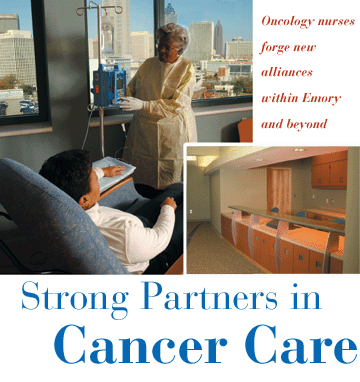
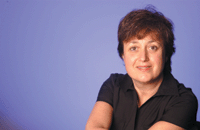
Right
now, we’re finding out what ‘best’ is and putting the pieces
together to see what works. We want to make the Georgia Cancer Center
of Excellence the best it can be, and we want the standards of care to
be the same for every cancer patient in Georgia.
— Dr. Roberta Kaplow
Clinical Professor of Nursing

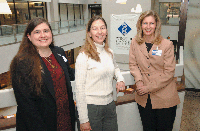
The
possibilities are endless. The collaboration between the WCI and the School
of Nursing will facilitate discoveries that are novel to the oncology
field.
— Karen Ivester(center)
Clinical Trials Administrator
Winship Cancer Institute
Pictured
above with advanced practice nurses Vickie Miller (left) and Cheryl Martin


By
virtue of the fact that nurses are with our patients around the clock,
they are truly the eyes and ears of the health care team... Our nurses
comprise the core elements that enable us to provide world-class cancer
care and treatment.
— Dr. Jonathan Simons
Director, Winship Cancer Institute

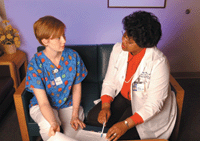
We see patients through very tough times. We take them
to the edge and back, and they remember who is there with them.
— Mary Gullatte, 81MN
Director of Oncology and
Transplant Nursing Services,
Emory and Emory Crawford Long hospitals and Director of Inpatient Oncology
Nursing, Winship Cancer Institute

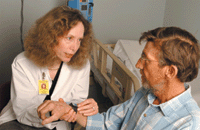
Conducting well-designed studies
focused on improving symptom management will help us provide better care
for cancer patients, whether it’s at the beginning, the middle, or
the end of their disease trajectory.
—Dr. Linda Alley, 72N, 75MN
Assistant Professor (Research) of Nursing
It’s
early morning at Grady Memorial Hospital, and the topic on the conference
room table is a tough one. Members of the interdisciplinary oncology care
team are wrestling with how to consolidate inpatient and outpatient forms
into one document that can flow from place to place with a patient. Their
long-term goal is to create a better record system and also help the Georgia
Cancer Center of Excellence at Grady Health Center operate efficiently.
Located
on two newly renovated floors at Grady Hospital, this state-of-the-art
facility puts everything in one place for patients—exam rooms, an
infusion center, inpatient beds, diagnostic imaging, medical records,
and a pharmacy. It is part of the Georgia Cancer Coalition, a public-private
partnership formed in 2000 by the governor to treat, prevent, and save
lives from cancer. Grady is the first center of excellence to open in
a statewide system offering the latest advances in cancer prevention,
research, and treatment to all Georgians.
Dr. Roberta Kaplow, a new faculty member in the Nell Hodgson Woodruff
School of Nursing, brings a lot of experience to the cancer center table
at Grady. A 20-year veteran of Memorial Sloan-Kettering Cancer Center
in New York, Kaplow is a clinical nurse specialist, educator, and researcher
well versed in the standards and technology of oncology patient care.
She arrived in Atlanta last fall to serve 50/50 as a clinical professor
in the School of Nursing (the school’s first full clinical professor)
and as a clinical leader and educator at Grady through the Winship Cancer
Institute (WCI) at Emory. In her dual role, Kaplow brings greater visibility
to the nursing school as a partner and leader in oncology nursing education,
patient care, and research in the Woodruff Health Sciences Center and
in Georgia.
Kaplow
is more than happy to do her part. “This is a privilege for me,”
she says, “because this is such a good place to be.”
As a clinical professor in the School of Nursing, Kaplow teaches baccalaureate
and master’s degree students about the complexities of cancer and
directs the oncology/immunology graduate program, for which she has strengthened
the curriculum and developed new materials. In addition to their required
courses, students enrolled in the master’s program complete more
than 600 hours of clinical practice. Each clinical experience is tailored
to the student’s interest in a patient population or disease specialty
at Emory or beyond. “If someone in Alabama is doing something of
interest to a student, we’ll arrange for that student to work with
that person,” says Kaplow.
At
Grady Hospital, she provides clinical instruction to the oncology nurses,
some of whom have staffed the giant public hospital for decades.
“The
nurses there are very special,” Kaplow says. “They are passionate
about what they do, and they want to do it better. To have that caring
aspect—you can’t buy that.”
Their
dedication and her own keep Kaplow focused on the mountains of paper she
carries back and forth to Grady each week. Most pertain to the standards
of care she is refining based on scientific evidence in the literature
and in collaboration with nurses and others with the Georgia Cancer Center
of Excellence. One of her first tasks was to create a patient assessment
summary. By using this form, the nurses can record their own observations
about a patient that may require care from another team member.
“The
pieces were already in place to provide multidisciplinary care, but there
was no consistent process that the nurses knew of to activate a referral
to the oncology care team,” Kaplow explains. “The patient assessment
summary has certain triggers on it to initiate a consult with the appropriate
person on the team. The form will help everyone communicate more clearly
with each other, which makes for a better patient outcome.”
“Right
now, we’re finding out what ‘best’ is and putting the pieces
together to see what works,” she adds. “We want to make the
Georgia Cancer Center of Excellence the best it can be, and we want the
standards of care to be the same for every cancer patient in Georgia.”
Bringing
down barriers
Cancer knows no boundaries when it comes to patients. The disease can
strike a business leader, an active teenager, a working mother, a farmer,
a grandparent, or a homeless person. Although cancer is the common denominator,
access to quality health care is not.
Dr. Otis Brawley is among the experts at Emory aiming to change that.
An expert in cancer prevention and health disparities, Brawley is associate
director of the Winship Cancer Institute. He also leads physician efforts
at the Georgia Cancer Center of Excellence at Grady, where many patients
cannot afford health care.
“The big question for the cancer center is how do we give optimal
care to a group of people who traditionally receive less than optimal
therapy?,” says Brawley, who came to Emory from the National Cancer
Institute (NCI) two years ago.
Brawley believes the answer lies with nurses and other health professionals
who know cancer patients best. “Nurses have a special relationship
with patients,” he explains. “Quality of life, the state of
well-being—these fall within the realm of nursing care and cancer
control research. Those things are very important to learning how to decrease
health disparities.”
For instance, nurses play a valuable role in combatting fatalism, which
is well documented among poor and minority patients. These patients often
are less motivated to follow their treatment regimens because they believe
they are going to die regardless. However, studies show that people who
have a more positive outlook about their treatment fare better with their
disease than people who don’t. That translates into survival.
Dr. Barbara Powe, a nurse researcher at the American Cancer Society (ACS)
and a new collaborator with the WCI and the School of Nursing, couldn’t
agree more.
“Research is key to changing behaviors for cancer screenings among
underserved populations,” says Powe, who directs special populations
research in the ACS Behavioral Medicine Research Center. “We need
to understand the factors that influence screening behaviors and make
sure the interventions match that.”
Nurses also affect the quality of health care for cancer patients by teaching
students and other professionals what they know. Roberta Kaplow is making
an impact in that regard.
“She represents Emory’s School of Nursing at Grady for cancer
care,” observes Brawley. “Part of how she is doing that is by
bringing nursing students to Grady to learn from oncology nurses who have
been in the trenches a long time.”
Both Brawley and Kaplow were attracted to Emory for a number of reasons.
A major draw was the leadership of Dr. Jonathan Simons, the WCI director
who is building the institute into one of the top US centers for cancer
care, research, prevention, and education. Later this year, the WCI will
occupy a new $76 million, 230,000-square-foot building—described
as a “discovery accelerator”—that will greatly expand clinical
and research space throughout the Woodruff Health Sciences Center.
Simons left Johns Hopkins three years ago to take up the reins of the
WCI. Once at Emory, he began looking at what the institute needed to become
an NCI-designated cancer center of excellence. To help achieve that status,
the WCI has recruited administrators, scientists, nurses, and others to
lead the way.
Karen Ivester is one of several advanced practice nurses who have joined
the WCI in the past year. She made the transition from HIV/AIDS research
to cancer research for a compelling reason.
“My sister was a WCI patient,” explains Ivester, clinical trials
administrator for the solid tumors and hematology/leukemia sections at
the WCI. “Her experiences made a great impact on me, and I and wanted
to assist in oncology research.”
Ivester also serves on the WCI’s Nursing Council, whose members come
from different areas of oncology nursing at Emory. It also is linked with
the School of Nursing, a partnership ripe with potential.
“The relationship between the WCI and the School of Nursing is one
that will grow and enhance the experience of nursing students, professors,
and WCI personnel,” says Ivester. “It will enhance nursing careers,
assist the WCI in recruiting researchers internally, and bring attention
to the School of Nursing as a place where research is part of the nursing
curriculum.”
“The possibilities are endless,” she adds. “The collaboration
between the WCI and the School of Nursing will facilitate discoveries
that are novel to the oncology field and will benefit patients.”
Finding the right nurse
Collaboration definitely is a high priority for Simons, who has sought
to tie the WCI more closely with its partners—Emory University and
Emory Crawford Long hospitals, The Emory Clinic, Grady Hospital, and the
Atlanta Veterans Affairs Medical Center (VAMC). Consequently, he relies
on a strong nursing leader to manage the standards of care for all of
these entities. That person is Mary Gullatte, 81MN.
Leadership has always coursed through Gullatte’s veins. The oldest
daughter in a family of 10 children in Mississippi, Gullatte was dubbed
“second mother in charge” by her working parents. After moving
to Atlanta in 1978, Gullatte joined Emory Hospital’s hematology/oncology
unit as a staff nurse.
She thrived immediately under the wing of experienced nurses like Edith
Honeycutt, 39N (for whom a chair in oncology nursing was named at the
School of Nursing in 1990). Eventually, Gullatte held successive management
positions, leading to her current appointment as director of Oncology
and Transplant Nursing Services for Emory
and Emory Crawford Long hospitals and Director of Inpatient Oncology Nursing
for the Winship Cancer Institute.
Not long ago, Gullatte added a book to her list of accomplishments. Working
with a multidisciplinary team of authors, Gullatte edited Clinical
Guide to Antineoplastic Therapy: A Chemotherapy Handbook (Oncology
Nursing Society, 2001) to provide nurses and other cancer professionals
with a practical reference source. Gullatte dedicated the book to the
people who inspire her—her family, her patients, their families,
and her colleagues.
“We see patients through very tough times,” she explains. “We
take them to the edge and back, and they remember who is with them.”
Gullatte entered her field at a time when nurses mixed their own chemotherapy
drugs and fewer treatment options were available. Those things have changed
for the better amid nursing’s steadfast commitment to providing holistic
care for the cancer patient.
“We do that well,” says Gullatte of her staff. “We also
work at a university teaching hospital, which challenges you to look at
evidence-based practice and to do critical thinking. There’s a strong
relationship between doctors and nurses. The doctors truly see nurses
as collaborative partners in caring for patients.”
Simons concurs with that assessment. “By virtue of the fact that
nurses are with patients around the clock, they are truly the eyes and
ears of the health care team. In our inpatient and ambulatory care environments,
our nurses comprise the core elements that enable us to provide world-class
cancer care and treatment.”
Managing symptoms counts
In every case, balancing treatment with symptom management is a constant
challenge. Caregivers at the VAMC often consult with Dr. Linda Alley,
72N, 75MN, to manage pain and improve sleep quality for cancer patients.
Her expertise comes from 30 years of nursing practice at the VAMC, where
she took the lead in establishing the inpatient and outpatient oncology
units and an institutional oncology nursing certification training program.
She also has conducted studies related to cancer, racial disparities in
health care, and health literacy.
Alley’s work exemplifies the School of Nursing’s focus on research
and evidence-based cancer care. As a postdoctoral fellow, Alley led three
pilot studies on pain and sleep in cancer patients. One was funded by
the nursing school’s Center for the Study of Symptoms, Symptom Interactions,
and Health Outcomes, directed by Associate Professor Dr. Kathy Parker
and supported by the National Institute of Nursing Research (NINR). The
center, one of 10 exploratory nursing research entities in the country,
is a catalyst for studies related to the center’s theme, which includes
cancer care.
“In many settings, not enough attention is focused on taking care
of cancer-related symptoms,” says Alley, who is a part-time assistant
professor (research) in the School of Nursing. “Pain management sometimes
is poor because patients tend not to complain about their pain. They also
may be reluctant to take pain medicine for fear they might become addicted
to strong opioids such as morphine.”
Like their patients, health care providers may worry that using drugs
with addictive potential may cause harm—despite medical literature
demonstrating that less than 1% of patients who take strong pain medication
for serious physical pain become addicted.
In other studies, results have been contradictory regarding patient satisfaction
with pain care. Although patients reported high satisfaction with pain
care, they continued to report high pain levels as well. This confusing
finding led Alley to examine the validity and response variability of
a nationally known instrument used to assess patient satisfaction with
pain management. After surveying 200 VAMC cancer patients, Alley demonstrated
the need to test additional satisfaction indicators (such as patient expectations)
not captured by current instruments.
“It’s not enough to ask patients if they’re satisfied,
‘yes’ or ‘no,’” says Alley. “We need to
ask meaningful questions that measure satisfaction with patients’
pain care as opposed to their simply being satisfied with efforts made
by care providers.”
Other factors are critical to her research. Alley’s pilot studies
on pain/sleep in cancer patients showed that pain may disrupt nighttime
sleep and daytime functioning but that opioids used to treat pain may
do so as well.
Currently, she is the principal investigator of a four-year, $1.4 million
NINR study to analyze more fully the effects of pain and opioid use on
the sleep/wake cycles of medical oncology patients. The study also will
examine how these sleep/wake cycles affect patients’ functional health
status and qualify of life. Working with Parker and researchers in the
School of Medicine, the WCI, and the VAMC, Alley will gather data from
80 patients using ambulatory polysomnography (the gold standard of sleep
measurement), pain/sleep diaries, and self-report survey data. Her study
is a first.
“Some studies have looked at pain, some studies have looked at sleep
disturbances, but no one has looked at both of those cancer–related
symptoms in the same patient population,” she says. “This information
can help us develop treatment regimens that maximize the benefits of pain
relief while minimizing the side effects of sleep disruption. Such regimens
will provide patients with good comfort through consolidated nighttime
sleep, improved daytime functioning, and high-quality pain relief.”
Alley has expanded her study in collaboration with the Promina Health
System in Atlanta through funding from the Georgia Cancer Coalition. She
will enroll 10 to 20 Promina patients as study subjects, in addition to
the 80 patients from Emory, Emory Crawford Long, and Grady hospitals,
and the VAMC.
“The more patients you have, the more power you have to confidently
answer the questions you are posing,” says Alley. “Conducting
well-designed studies focused on improving symptom management will help
us provide better care for cancer patients, whether it’s the beginning,
the middle, or the end of their disease trajectory.”